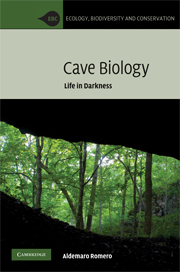Book contents
- Frontmatter
- Contents
- Preface
- Acknowledgments
- 1 A brief history of cave biology
- 2 Cave biodiversity
- 3 The evolutionary biology of cave organisms
- 4 The ecology of cave organisms
- 5 Cave conservation and management
- 6 Epilogue
- Appendix 1 Glossary of terms frequently used in biospeleology
- References
- Index
- Plate section
Preface
Published online by Cambridge University Press: 21 October 2009
- Frontmatter
- Contents
- Preface
- Acknowledgments
- 1 A brief history of cave biology
- 2 Cave biodiversity
- 3 The evolutionary biology of cave organisms
- 4 The ecology of cave organisms
- 5 Cave conservation and management
- 6 Epilogue
- Appendix 1 Glossary of terms frequently used in biospeleology
- References
- Index
- Plate section
Summary
Let me say from the outset that this book will challenge much of the conventional wisdom regarding the biology of caves. There are several reasons for that. As the reader will perceive throughout the text, biospeleology has tremendous potential to inform many aspects of modern biology, yet this area of knowledge remains largely anchored in non-neo-Darwinian views of the natural world in both its approaches and its jargon. Therefore the ideas I present here are likely to create controversy in some quarters, but that is one of the approaches of science: to generate discussions that hopefully will illuminate many aspects of the workings of nature.
The reader should not expect an attempt to condense everything known about cave biology; this book is not written with an encyclopedic mindset. What this book is all about is a critical examination of our current knowledge and ideas regarding cave biology, with an emphasis on the areas of evolution, ecology, and conservation. To that end I have selected material for the discussion that is central to those topics while taking a critical thinking approach to what is considered conventional wisdom in this subject.
The book begins with a historical analysis of ideas that have influenced biospeleology and that have been generated by researchers working in that area. Thus the aim of Chapter 1 is to give the historical and philosophical background to why I think cave biology has yet to reach its full potential.
- Type
- Chapter
- Information
- Cave BiologyLife in Darkness, pp. xi - xiiPublisher: Cambridge University PressPrint publication year: 2009

